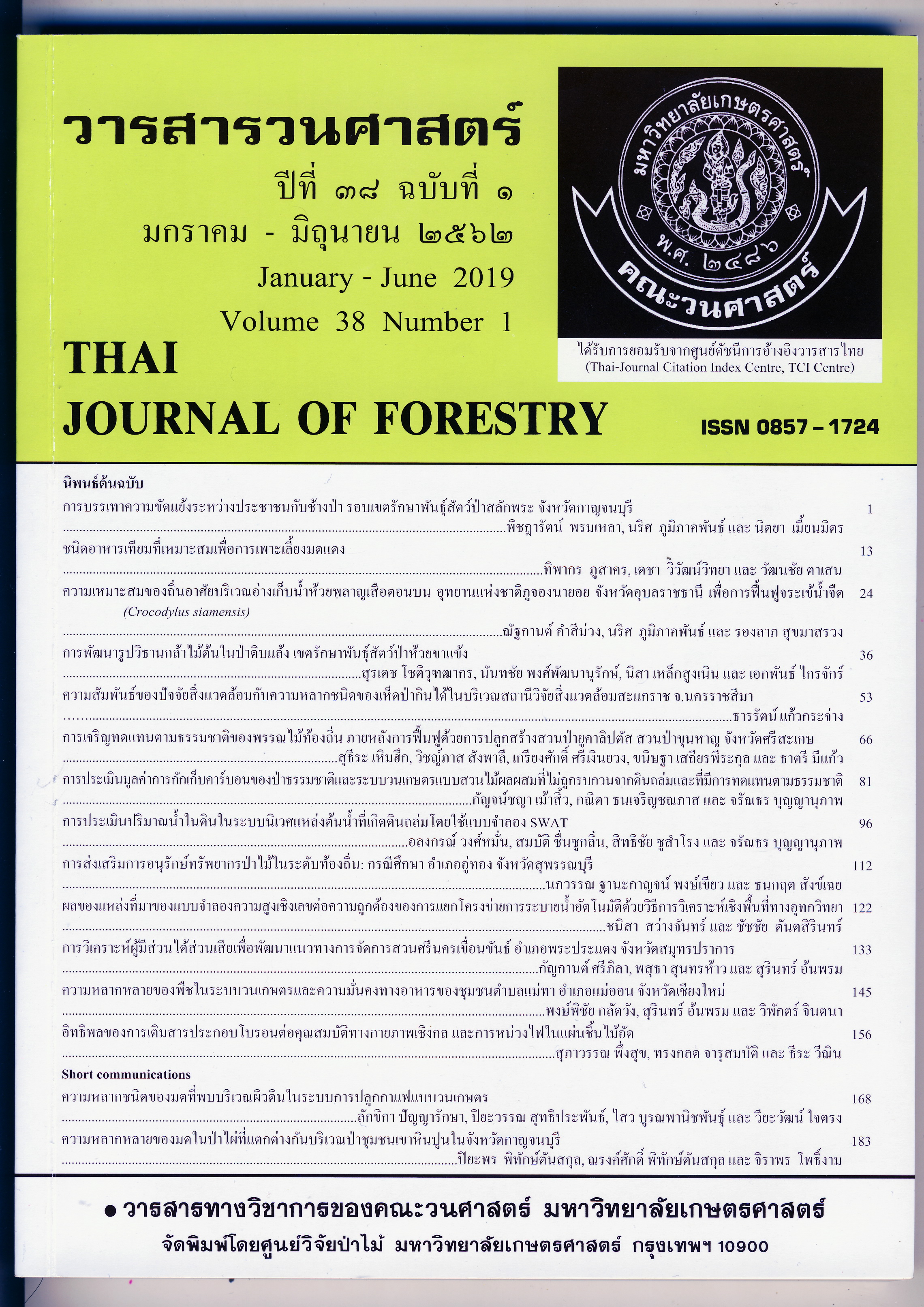การบรรเทาความขัดแย้งระหว่างประชาชนกับช้างป่า รอบเขตรักษาพันธ์ุสัตว์ป่าสลักพระจังหวัดกาญจนบุรี
Main Article Content
บทคัดย่อ
การศึกษานี้ มีวัตถุประสงค์เพื่อทราบความเสี่ยงต่อการเกิดความขัดแย้งระหว่างประชาชนกับช้างป่า ในพื้นที่แนวกันชนระยะ 5 กิโลเมตรรอบแนวเขตรักษาพันธุ์สัตว์ป่าสลักพระ และประมาณค่าใช้จ่ายที่เกษตรกรต้องจ่ายในการประกันภัย โดยการคำนวณอัตราการจ่ายเบี้ยประกันภัยต้นทุนการผลิตพืชผลทางการเกษตรที่ถูกช้างป่า (Elephas maximus) เข้าทำลาย เพื่อช่วยแก้ไขปัญหาค่าเสียหายที่ถูกช้างป่าเข้าทำลายพืชผลทางการเกษตร และช่วยลดภาระค่าใช้จ่ายของภาครัฐในการเยียวยาความเสียหายที่เกิดจากช้างป่า โดยผู้วิจัยมั่นใจว่าระบบการประกันภัยพืชผลทางการเกษตรจะสามารถเป็นแนวทางหนึ่งที่ช่วยในการการบรรเทาปัญหาความขัดแย้งระหว่างประชาชนกับช้างป่าลงได้
พื้นที่เสี่ยงต่อการเกิดความขัดแย้งระหว่างประชาชนกับช้างป่า รอบแนวเขตรักษาพันธุ์สัตว์ป่าสลักพระ จากการใช้เทคนิคการซ้อนทับข้อมูล (Overlay Techniques) ปัจจัยทางกายภาพที่มีอิทธิพลต่อการเลือกใช้ประโยชน์พื้นที่ของช้างป่า พบว่า ในระยะ 5 กิโลเมตรจากแนวเขตรักษาพันธุ์สัตว์ป่าสลักพระ คิดเป็นพื้นที่ทั้งหมด 883 ตารางกิโลเมตร มีพื้นที่เสี่ยงต่อการต่อการเกิดความขัดแย้งระหว่างประชาชนกับช้างป่า แบ่งเป็น 3 ระดับ ดังนี้ พื้นที่เสี่ยงน้อย 287.65 ตารางกิโลเมตร พื้นที่เสี่ยงปานกลาง 191.28 ตารางกิโลเมตร และพื้นที่เสี่ยงมาก 404.07 ตารางกิโลเมตร คิดเป็นร้อยละ 32.58, 21.66 และ 45.76 ตามลำดับ
การประมาณค่าใช้จ่ายที่เกษตรกรต้องจ่ายในการประกันภัย จากการสัมภาษณ์เกษตรกร ผู้ได้รับผลกระทบจากช้างป่า ใน 2 หมู่บ้านรอบเขตรักษาพันธุ์สัตว์ป่าสลักพระ เพื่อนำมาคำนวณค่าเบี้ยประกันภัยรายปี พบว่า ข้าว มันสำปะหลัง ข้าวโพด อ้อย ยางพารา ไม้ผล และอื่นๆ มีอัตราการจ่ายเบี้ยประกันภัยต้นทุนการผลิตพืชผลรายปี เท่ากับ 1,769.94, 496.63, 532.66, 1,990.40, 230.08, 287.55 และ 5.76 บาทต่อไร่
Downloads
Article Details
ข้าพเจ้าและผู้เขียนร่วม (ถ้ามี) ขอรับรองว่า ต้นฉบับที่เสนอมานี้ยังไม่เคยได้รับการตีพิมพ์และไม่ได้อยู่ในระหว่างกระบวนการพิจารณาตีพิมพ์ลงในวารสารหรือสิ่งตีพิมพ์อื่นใด ข้าพเจ้าและผู้เขียนร่วม (ถ้ามี) ยอมรับหลักเกณฑ์และเงื่อนไขการพิจารณาต้นฉบับ ทั้งยินยอมให้กองบรรณาธิการมีสิทธิ์พิจารณาและตรวจแก้ต้นฉบับได้ตามที่เห็นสมควร พร้อมนี้ขอมอบลิขสิทธิ์ผลงานที่ได้รับการตีพิมพ์ให้แก่วารสารวนศาสตร์ คณะวนศาสตร์ มหาวิทยาลัยเกษตรศาสตร์ กรณีมีการฟ้องร้องเรื่องการละเมิดลิขสิทธิ์เกี่ยวกับภาพ กราฟ ข้อความส่วนใดส่วนหนึ่ง หรือ ข้อคิดเห็นที่ปรากฏในผลงาน ให้เป็นความรับผิดชอบของข้าพเจ้าและผู้เขียนร่วม (ถ้ามี) แต่เพียงฝ่ายเดียว และหากข้าพเจ้าและผู้เขียนร่วม (ถ้ามี) ประสงค์ถอนบทความในระหว่างกระบวนการพิจารณาของทางวารสาร ข้าพเจ้าและผู้เขียนร่วม (ถ้ามี) ยินดีรับผิดชอบค่าใช้จ่ายทั้งหมดที่เกิดขึ้นในกระบวนการพิจารณาบทความนั้น”
เอกสารอ้างอิง
Ansuchote, N. 2008. The Study of Human-Elephant Conflict Alleviation: A Case Study of Tumbon Wangdong, Amphoe Muang, Kanchanaburi. M.S. Thesis, Mahidol University.
Bhumpakphan, N. 2014. Elephant Solution. In Proceedings of Elephant Situation and Solution. 12 November 2014. Forestry Research Center, Bangkok.
Camilla, M. 2013. Investigating the role of land beside the south-east boundary of Salakpra WS for the conservation of elephants, other wildlife and the ecosystem integrity of the conservation area. Elephant Conservation Network, Thailand.
Chanchaeng, P. 2010. Drought Risk Area Assessment in Kamphaeng Saen District, Nakhon Pathom Province Using Geographic Information System. M.S. Thesis, National Institute of Development Administration.
Chen, S. 2012. Mitigating People-elephant Conflict in Xishuangbanna, China. M.S. Thesis, National University of Singapore.
Chokcharoen, R. 2012. Ecology of Asian Elephant (Elephas maximus Linnaeus, 1758) in Phu Wua Wildlife Sanctuary, Bueng Kan Province. M.S. Thesis, Kasetsart University.
Dongmanee, N., R. Sukmasuang, R. Potitan and S. Sariman. 2017. Opinions of People on Human and Elephant Conflict Problem Solution by Moat around Khao Ang Rue Nai Wildlife Sanctuary, Chachoengsao Province. Thai
Journal of Forestry 36 (2): 107-118.
Kanchanasakha, B., S. Thunhikorn, S. Vinitpornsawan, U. Prayoon and K. Faengbubpha. 2010. Status of Large Mammals in Thailand. Wildlife Research Division Department of National Park Wildlife and Plant Conservation,
Thailand.
Lekagul, B. and J.A. McNeely. 1988. Mammals of Thailand, 2nd ed. Kurusapha Ladprow Press Bangkok, Thailand.
Lorchirachunoonkul, V. and W. Chaisilaparungruang. 2003. Crop Production Cost Insurance in Thailand. Journal of Research Methodology 16 (4): 563-602.
Phiphat, P. and S. Suksard. 2014. People Opinions on Thailand’s Wild Elephant Food Security Fund (TEFS): A Case Study of Khlong Khrua Wai Chalerm Pra Kiet Wildlife Sanctuary, Chanthaburi Province. Thai Journal of Forestry 33 (2): 113-122.
Prempree, P. 2012. Elephant Situation in Salakpra Wildlife Sanctuary. Department of National Park Wildlife and Plant Conservation, Thailand.
Siripon, S., Y. Trisurat, and R. Sukmasuang. 2014. Impact of land use change on wild elephant habitat in Salakpra Wildlife Sanctuary, Kanchanaburi province. Journal of Wildlife in Thailand 21 (1): 138-149.
Sripha, J., P. Tongdeenok and S. Tantanasarit. 2013. Factors affecting people participation in forest resource conservation in Salakpra Wildlife Sanctuary, Kanchanaburi Province. Thai Journal of Forestry 32 (2): 80-88.
Sukmasuang, R. 1993. Ecology of Asian Elephant (Elephas maximus Linnaeus, 1758) in Huay Kha Khaeng Wildlife Sanctuary Changwat Uthai Thani and Tak. M.S. Thesis, Kasetsart University.
Sukmasuang, R., N. Bhumpakphan, N. Thongtip and W. Arunpraparat. 2013. Strategic plan for elephant conservation and mitigation of their problems in Thailand, pp. 43-44. In Proceedings of the 34th Thailand wildlife seminar. 19-20 December 2013. Kasetsart University, Bangkok.
Youngpoy, N. 2012. Population and Activities of Wild Elephant (Elephas maximas) in Salakpra Wildlife Sanctuary, Kanchanaburi Province, Thailand. M.S. Thesis, Mahidol University.


